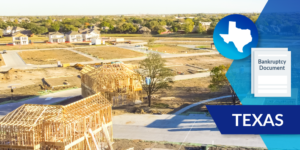
The world is watching the construction industry continue to grow this year after a strong 2021, when total construction spending reached an all-time high of $1.57 trillion. Unfortunately, the lingering effects of the COVID-19 pandemic and the faltering global supply chain are continuing to put pressure on contractors who are looking to capitalize on this construction boom.
Payment problems are holding companies back as they often are — as per Levelset’s 2022 Construction Cash Flow & Payment Report, just 12% of businesses report always getting paid on time and only 39% report getting paid in under 30 days on average. Payment issues very often lead directly to bankruptcy, which is in turn leading to major issues for contractors in some of the largest states for construction work, such as Texas.
In March 2022, Texas had seven contractors who filed for Chapter 7 bankruptcy, followed by the six who filed for Chapter 7 and two for Chapter 11 protection in April. That pattern has continued, as the number of total construction bankruptcies grew to 10 total in May 2022 — six Chapter 7 cases and four Chapter 11 cases.
The six companies that filed for Chapter 7 bankruptcy exhibit a large range of financial situations that point out just how difficult it is to balance payments and maintain profitability:
- Evergreen Painting & More, LLC (May 12)
- Brecker Realty Development, LLC (May 12)
- Alpha Construction and Maintenance Inc. (May 23)
- Amenity Solutions, LLC (May 24)
- Kyros Industries, LLC (May 24)
- Burnside Services, Inc. (May 31)
Chapter 7 bankruptcy is often referred to as liquidation bankruptcy. It typically doesn’t allow for the filing of a plan of repayment, instead it provides for a debtor’s nonexempt assets to be sold in order to pay off its creditors. Even though certain property can be held as exempt, Chapter 7 filings most often result in the loss of most (or all) of a company’s assets and property — and often up in the closure of the business itself.
This group of companies has a large range of individual situations. Alpha Construction and Maintenance hasn’t had an issue with revenue — they reported between $500,000 and $1 million in revenue during the past year — but only has less than $50,000 in assets, putting it in an untenable situation even when compared to its less than $50,000 in liabilities. On the other end of the spectrum, Burnside Services listed between $10 million and $50 million in assets — but lists the same range in its liabilities while noting $5 million to $10 million in revenue during the previous year, showing how precarious the situation can be even for companies that deal with significant amounts of money.
Learn more: How Bankruptcy Impacts a Construction Project
The state’s Chapter 11 bankruptcy filings were fewer, but include some huge companies:
- RDS Construction, LLC (May 2)
- A+ Remodeling & Construction, Inc. (May 9)
- Talen Energy Supply (May 10)
- Alcon Contractors, LLC (May 10)
Chapter 11 bankruptcy is usually referred to as “reorganization” bankruptcy, as it generally allows the debtor to remain in possession of its assets and to continue operating its business while at the same time proposing a plan of reorganization in order to pay its debts. In a best-case scenario, these companies can make it through the process without too significant a loss of assets or property.
One of the major stories of the state’s bankruptcy issues this month comes from one of its Chapter 11 cases, however. Talen Energy Supply — a major Texas-based energy supplier and contractor which maintains 18 power generation facilities across the country — filed for protection in order to restructure $4.5 billion in debts.
Smaller companies in this group are struggling to reorganize their debts, as well. Alcon Contractors has between $1 million and $10 million in liabilities, but lists less than $50,000 in total assets.